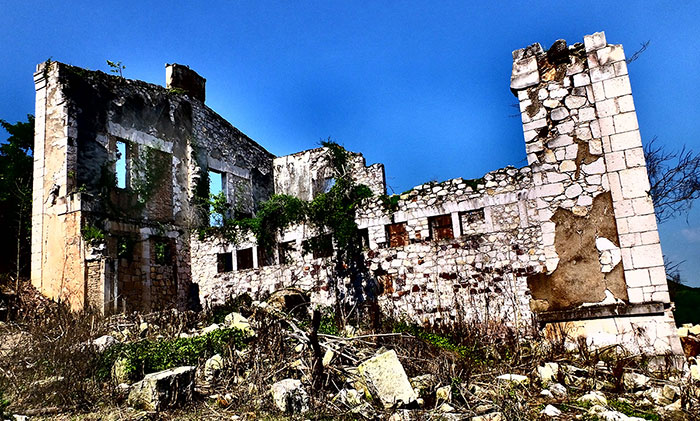|
By John Pint
 Etzatlán is a busy town
located 66 kilometers west of Guadalajara and is a fine place to visit
after touring the nearby Guachimontones
of Teuchitlán.
The town's historiador, Carlos Enrique Parra Ron, recently invited me
to see a small mining museum he has set up inside the recently
renovated Etzatlán train station, now transformed into a cultural
center. Etzatlán is a busy town
located 66 kilometers west of Guadalajara and is a fine place to visit
after touring the nearby Guachimontones
of Teuchitlán.
The town's historiador, Carlos Enrique Parra Ron, recently invited me
to see a small mining museum he has set up inside the recently
renovated Etzatlán train station, now transformed into a cultural
center.
The mines of Etzatlán go back at least to the 1500s when
they were producing vast wealth for the Spanish crown. According to
University of Guadalajara researcher C. René de León Meza,
“norteamericanos” bought the San Juan and Santo Domingo mines in 1903
and incorporated the Amparo Mining Company in Philadelphia,
Pennsylvania.
In 1916, the Amparo mines were the most important
in Jalisco and their reserves were estimated at 550,000 tons. Between
1924 and 1931 the company produced 2,933 kilograms of gold and 138,597
kilos of silver. In 1928 the company had 523 employees who worked the
mines 356 days a year. Amparo was one of the very few mining companies
that kept operating right through the Mexican revolution.
Those
are the statistics, but inside the Etzatlán train station, Señor Parra
gave us a feeling for the human side of the Amparo operations.
“The
owners were very much interested in culture,” he told us. “They set up
an orchestra of 36 musicians as well as other orchestras of children
and adults. They built a theater and promoted literature and
sport. In fact, the greatest actors and actresses of Mexico, after
performing at the Degollado in Guadalajara, would some straight to El
Amparo to give another performance. And Amparo was tops in medicine,
too. In those days Jalisco had only two X-ray machines: one in
Guadalajara and the other at Amparo.”
When asked how Amparo
eventually turned into a ghost town, Parra said that 1927 marked the
beginning of the end, with the arrival of “a man who had participated
in the Russian revolution, who fought with the Republicans against
Franco, who was involved with the assassination of Trotsky and who is
also one of the three greatest muralists of Mexico.”
Of course,
Parra was referring to David Alfaro Siqueiros, who had come to unionize
the miners and allow them to participate in the riches of the Amparo
mines. This turn of events caused the owners to have second thoughts
about their operations. In the case of Amparo, profits had been
dropping, so, rather than deal with a union, the owners preferred to
pull out in 1938, leaving the Amparo mine in the hands of the union
leaders.
“Once the union leaders took over,” said Parra, “they
preferred to spend the mine's profits on wine, women and song rather
than on equipment and maintenance, provoking a rapid decline that ended
with the miners dismantling and selling all the machinery, leaving
Amparo stripped bare and abandoned.”
After looking at photos and
relics of Amparo's years of glory, we left the mini-museum to go see
the ruins of the mining town with our own eyes.
One good thing
about the road to Amparo is that it's dead easy to follow. From the
train station you just head south on Calle Allende, which takes you
straight through town and onto the winding road to the old mining
camp. After only 5.2 kilometers you come to El Mirador,
offering
a magnificent view of the town and surrounding hills. This is a popular
spot, so the cobblestone road leading to it is kept in good condition,
but if you plan to continue on to Amparo, you'll need a vehicle with
high clearance.

From
the Lookout Point, a nine-kilometer drive brings you to Amparo's plaza,
where you'll find a recently built kiosk, but not a lot of human
beings. Here we parked and walked a grand distance of 245 meters to the
ruins of a once beautiful building where the miners received their
wages after drawing a line (raya) if they couldn't sign their name.
From here it is only a 350-meter walk to one of the old mine entrances,
but in the rainy season be prepared to hop from rock to rock across two
small streams.
In bygone years the mine tunnel looked in good
shape, but, since my last visit, it has collapsed inside, leaving only
the entrance intact, probably all the better since old mines are
notoriously dangerous.
There are a
lot more ruins to be seen at Amparo, but we jumped back in our vehicle
and drove on towards Las Jiménez on a tortuous road which definitely
requires four-wheel drive. The view, however, was spectacular and after
4.5 kilometers, we reached the milling area where rocks from the mine
were crushed to ever smaller sizes until they were reduced to powder,
from which silver and gold were extracted. Just above the crushers
stand the remains of a once majestic building which, it is said, once
housed huge transformers. I'm not convinced, since this building looks
very elegant for so menial a task. Here local boys told us they are
fixing up a place for tourists to stay. They looked delighted that a
couple of gringos had shown up even before their cabin had been
finished.

If you'd like to read
some hair-raising tales of life at this old mine, see “Ruins
and memories of Mexico's El Amparo Mining Company” which
features selected memoires of Engineer Salvador Landeros. If you find
this interesting, you must surely read The Dark Side of the Amparo
Mine Story, which
explains why and how mining operations at Amparo came to an end.
How
to get there
From
the Guadalajara periférico, take highway 15 (Nogales and Tepic) 25
kilometers to highway 70 which heads southwest towards Ameca.
Go about
17 kilometers to the Tala turnoff, but instead of turning, go over the
bridge and continue straight towards Ameca for about 1.5 kilometers.
Now turn right onto the road heading for Teuchitlán and Ahualulco. From
this turnoff, it’s about 40 kilometers to Etzatlán. As you approach the
town, you’ll see a Pemex gas station on your left. Turn left here and
after 130 meters, turn right. This will take you to the old train
station housing the mining museum. By the way, the railroad came way
out here just to carry off ingots from the mine. Here you can turn left
onto Allende Street and follow it south through the town and up to the
Mirador. You'll find the entire route to Amparo (N20.70005 W104.08242)
and Las Jiménez (N20.68398 W104.07251) here.
|

